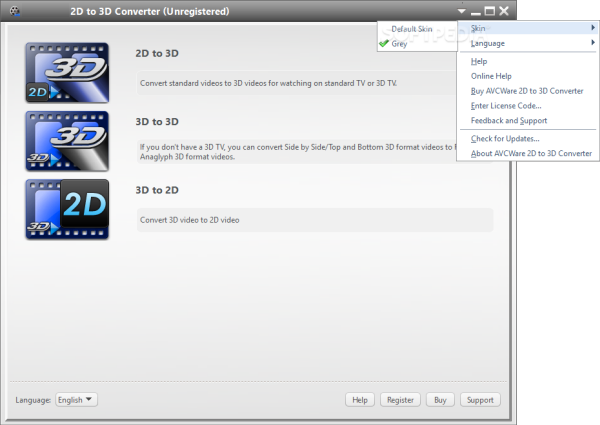
#W1070 2d to 3d conversion update pro#
In some cases, it's easier to create a new scene in ArcGIS Pro using the same data. Because ArcGIS Pro and ArcScene have different 3D environments, you may need to work with the map and layer properties of an imported ArcScene document to make it display the way you want. ArcScene documents open as local scenes and ArcGlobe documents open as global scenes. In addition to converting maps to scenes, you can import existing 3D documents from ArcScene and ArcGlobe. For this reason, you may want to set the elevation source for the buildings back to the ground. The values in the Buildings layer may be more accurate, but it's also important for this layer to align with the other layers in the scene. The Base Elevation values in the Buildings layer and the values in the Elevation_Kelburn surface were probably captured or processed in different ways in any case, they don't match exactly. This can happen when multiple elevation surfaces are used in a scene. In several places, the buildings are partly sunken in the terrain. In this section, you'll change the elevation source of the Buildings layer to this attribute field instead of using the elevation surface values. However, it's different from the other 2D layers in the scene because it does store elevation values-not as part of its geometry, but in another field. A 2D layer uses the values of the scene's elevation surface to draw in 3D space. By default, a 3D layer uses its own z-values to draw in 3D space.Ī layer is 2D if it does not store z-values as part of its geometry. You can recognize a 3D layer by the Shape field of its attribute table: the values will have a Z at the end, such as PointZ, PolylineZ, or PolygonZ. Ī map layer is 3D if it stores z-values as part of its geometry. On the Quick Access Toolbar, click Save.You can drag elevation layers up and down within the Elevation Surfaces category. You should put high-resolution layers above low-resolution layers. To learn more about custom elevation surfaces, see Elevation surfaces.Įlevation layers are used in the order in which they are listed in the Contents pane. However, surfaces can represent other topographies, such as cave floors or lake beds, if you have suitable datasets. In most scenes, the elevation surface represents the ground: the topography of the earth's surface.

Map layers will use the elevation values of the high-resolution layer where they are available. The Kelburn suburb at a resolution of 1 meter. In this section, you'll add a second ground elevation layer. For example, a high-resolution layer may provide elevation values for a small area of interest, while a low-resolution layer provides elevation values for surrounding areas. You can add more than one layer to an elevation surface. WorldElevation3D/Terrain3D is a fairly low-resolution surface. Surfaces that cover large areas generally have lower resolution (less detail) than surfaces that cover small areas. The resolution of the surface-the amount of elevation detail it contains-may be high or low. In the next section, you'll add another elevation surface to the scene to provide more detailed elevation values for the Kelburn suburb.Īdd another elevation surface to the sceneĪn elevation surface is a raster or TIN dataset (or a web elevation layer created from a raster dataset) that stores elevation values for a continuous geographic area. Alternatively, use the on-screen navigator in the lower left corner of the scene. Use the mouse buttons and mouse wheel to zoom, pan, tilt, and rotate the scene.In the Navigate group, make sure the Explore tool is selected. Of the world, open the Elevation Coverage Map.įrom the current perspective, the scene doesn't look very 3D, but you'll take a few moments to explore it from other perspectives. WorldElevation3D/Terrain3D resolution and data source for any part Square meters of area (31 meters squared). Meters, meaning there is one elevation value for every 961 In New Zealand, the resolution is approximately 31 It's a composite of many elevation maps with varying

WorldElevation3D/Terrain3D is a worldwide elevation surface. (Expand the Ground heading to see the layer.) This layer provides elevation values for the 2D map layers so they draw in 3D space. At the bottom of the pane is an Elevation Surfaces category with a ground layer named WorldElevation3D/Terrain3D. In the Contents pane, the map layers have been copied to the scene. They use the WGS 1984 geographic coordinate system. Global scenes don't support projected coordinate systems.


Local scenes support projected coordinate systems. You can view any scene as a global scene or a local scene by clicking Global or Local in the View group on the View tab.


 0 kommentar(er)
0 kommentar(er)
